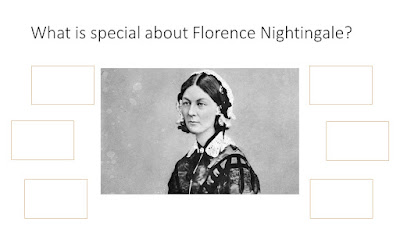The example of the planning grid continued: Reception Phase for Florence Nightingale
To llustrate what was said in the last blog entry, I have filled in the Reception Phase in the plannig grid for the unit on Florence Nightingale. As we said in this last entry, the work on the text type biography starts with some exercises that prepare students to read, understand and enjoy the text. In this case, since the text is somewhat specialized as it talks about nursing, I decided to do some vocabulary work to start with. The other possible source of difficulty our students may have is related to the relevance of Florence Nightingale as one of the few upper-class women in the 19th century to be able to work. Without an awareness of how unusal this situaton was 200 years ago, most students will probably not fully understand the relevance of the person we are dealing with in this unit - hence the next two taks in the teaching sequence.
With the scene thus set for the students to be able to understand the text, we ask them to predict its content. This is a reading strategy which I could include as a teaching point in the chart on the first page, but since this particular text is very well suited to highlighting the usefulness of graphic organizers for reading, it was decided that prediction would not feature among the strategies dealt with here. Having said this, students are still asked to predict, as a way of practising a strategy that they will focus on in a future unit of work, or because the have already used this strategy before.
So far the sequence of tasks recorded in the planning grid has been quite straightforward, but now it becomes a bit less so, as the second task is done in lesson 2, while the third one is planned for lesson 3. This is so because once students have understood the text, differet aspects are worked on that imply that students will have to go back to the text several time to focus on them. In lesson 2 the focus is on the different events in Florence's life, which are recorded with the help of a timeline. In the context of this work, students' attention is focused on the temporal linkers used. This shows how the language work is contextualized through working on a specific text and highlighting its features. These temporal linkers are then recorded on some kind of display that can be further enriched as students move through the unit. When students are asked to produce their own biographies at the end of the unit, they can refer to this anchor chart to help them use the appropriate linkers.
The second graphic organizer used in the unit helps students record some of the features that make Florence special. Here more detailed and inferential reading is asked for, and this is related to the structure of the biography, and more specifically to its last paragraph, where the importance of the character described is highlighted. In a third reading the factual nature of a biography is stressed, which is, in turn, related to the use of the past tense. Ths means that, as was explained before, the work on the different textual and linguistic teaching points is integrated with the actual reading and understanding of the text. The idea is always to provide students with an understanding of the model text and, at the same time, with the building blocks for their own production. This, as we see in our students, makes their learning more meaningful and memorable.




Comments
Post a Comment